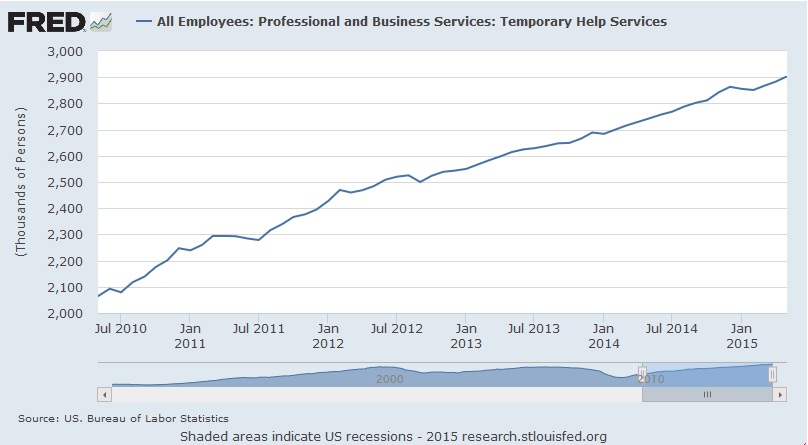In the future, will employees become extinct? All over the world, from the United States to Japan, businesses of all sizes – corporations and small enterprises – are gradually phasing out the employee.
Contractual workers are becoming the norm, while firms are taking on freelancers.
Crowdsourcing the new reality in labor market
Uber is the latest sensation in the marketplace.
The ride-sharing app allows consumers to save money on transportation, while the drivers earn a little bit of extra cash.
Of course, the drivers aren’t employees but rather contractors. The real number of staffers at Uber is 2,000, compared to the estimated 160,000 contractors picking up passengers worldwide.
It isn’t just Uber that is contributing to the dismissal of the conventional employee and embracing the so-called 1099 economy.
Amazon recently made headlines after it was reported that the online retail juggernaut is considering incorporating an Uber-like delivery service into its business model.
The company would crowdsource drivers to drop off packages at customers’ residences or businesses. Details of the project – pay, fees, launch date – remain unknown
Other popular and successful crowdsourced services include Deliv, Instacart, GrubHub and Google Express. Even Wal-Mart mulled over the idea of launching a crowdsourced delivery service in 2013, but the retail giant quickly put the concept on hold.
Crowdsourcing isn’t the only factor to consider when discussing the demise of the employee.
The rise of the permanent temp worker
Job creation may be lackluster, but there is one area of the U.S. economy, and in other developed nations, too, that is booming: temporary workers.
Temp workers are becoming the perpetual fixture in an economy where labor competition is fierce and high-paying positions are scarce.
Many multi-national corporations and well-known brands have saved an incredible sum of money on labor costs by using workers that aren’t really their employees. FedEx, General Motors, McDonald’s and PepsiCo are just some of the companies to have staffers that work for subcontractors, franchisees, vendors and others.
Millennials may be content with the adjusting labor practices, though. Take this BLS figure: the average 55-year-old spends on average 10 years at a job, while the average 25-year-old spends three. Job hopping has quickly become the accepted norm.
Furthermore, millennial workers will opt for lower pay if it means they can work remotely and receive flex work.
At the same time, this won’t equate to retirement pensions or workplace benefits for future generation of workers.
But in the mindset of millennials: meh.
Although this is seen as a modification to the traditional economy with things like flexible work hours, it may prove to be a bane for millions of professionals and unskilled laborers across the globe.
Why? If you’re not a full-time, 9-to-5 employee then it means fewer hours, wages and benefits.
Since the official end of the Great Recession, the number of temps has substantially risen by more than 50 percent to 2.7 million. This is the biggest increase since the government began to record these figures in 1990. It’s apparent that businesses aren’t hiring for the long-term, according to economists.
Here is Federal Reserve Economic Data (FRED) on the number of temp help since Jul. 2010:
The labor force participation rate is another key indicator of the decline in long-term employment.
According to the Bureau of Labor Statistics (BLS), it stands at a 37-year low with 62.8 percent (as of Jan. 2015).
Here is a chart from the U.S. statistics agency:
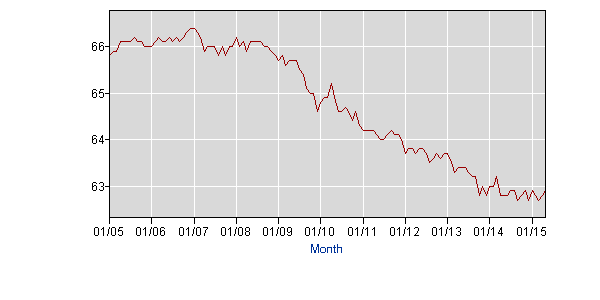
The long-term unemployment rate by the BLS is another important statistic to follow. This represents the number of Americans unemployed for 27 weeks or longer. One aspect of this calculation that should be noted is that these workers would like to get more hours but can’t find the work.
Although it has dipped in the last three years, it is nowhere near 1990s levels.
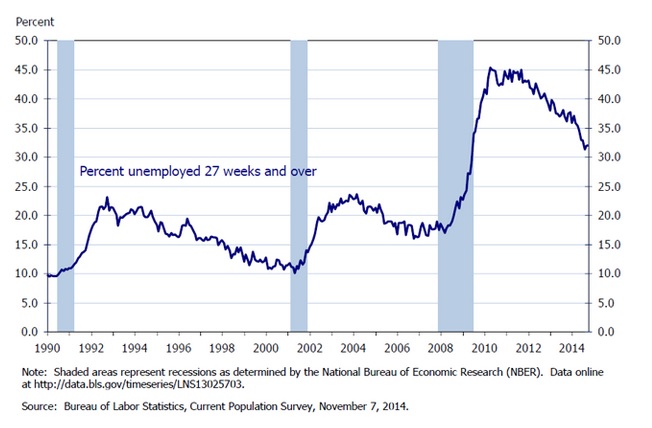
In a May 2013 Associated Press survey of 37 economists, three-quarters believed the growing adoption of contract and temp workers is an established trend, and will be in the long run.
Moreover, for those that believe temp jobs can convert into full-time employment opportunities, consider this statistic: just 18 percent of temp work transitions into full-time work .
Manufacturing, a contentious sector that generates a lot of debates, is swarmed with temps. It is approximated that one-third of temps find jobs in production lines, warehouses stocking goods and repairing machinery. Another 20 percent work in administration. Ditto for the hospitality industry.
Even essential services, like healthcare and education, are welcoming temps into the fold.
In hospitals, due to the shortage of doctors and nurses, human resources turn to staffing agencies; it was predicted that temp doctors would spike to record highs beginning in 2013. In schools, principals take on substitute teachers from temp firms because then it diminishes the amount of retirement benefits school districts have to allocate. Remember, cities and states are having to handle fiscal restraint and tightened budgets.
Public and private sector unions are pushing back, but not much progress has been made.
Some media outlets chime in, like Erin Hatton of the New York Times did in 2013, who opined: “According to the temp industry, workers were just another capital investment; only the product of the labor had any value. The workers themselves were expendable.”
In an era when companies are celebrated for restructuring into lean and mean operations, the idea of temp workers transitioning into the norm isn’t generating buzz on Wall Street or ruffling feathers on Main Street. It’s the elephant in the room that nobody wants to talk about. Businesses want to please shareholders and politicians don’t want to appear to be inept.
The White House seemed to take some measures. President Obama installed David Weil at the Department of Labor in order to enforce federal wage laws and hold businesses accountable for the way they treat subcontractors and temp workers. Some new regulations and court rulings may prompt companies to reshape their labor models, but it likely won’t prohibit contract, franchise or temp workers.
A global phenomenon
If you think the matter of contract, temp workers is relegated only to the U.S. then you are mistaken. It seems almost ecumenical in relation to temp work.
Our Time Doctor software has picked up on the fact that our customers are hiring workers from home in countries all over the world simply because it’s too costly to hire workers in their respective country.
Canada
In Canada, temp work, also referred to as “precarious work” is rising at a faster pace than permanent jobs.
Statistics Canada reported in 2013 that the number of temp workers in the Great White North reached a record two million, which accounts for just under 14 percent of the workforce, up from 11.3 percent in 1997.
These numbers have been exacerbated since the financial crisis.
Temp work has soared more than triple the pace of permanent employment: up 14.2 percent for temp work between 2009 and 2012, compared to 3.8 percent for permanent employees.
Since 1997, the biggest demographic to be involved in temp worker is young people. Also, temp positions are most ubiquitous in the sectors of arts, education, hospitality and food services. The greatest growth has been concentrated in the provinces of British Columbia and Ontario.
“You’re either a winner or loser in this labor market,” said Wayne Lewchuk, professor of labor studies at McMaster University in Hamilton, in an interview with the Globe and Mail. “The clear winners [are those] with great, stimulating, well-paid jobs. But a lot of others [exist] in a treadmill of insecurity, with little training and a limited career path.”
Temp work may be an issue in Canada, but what may be the most concerning is the increase in foreign temporary workers.
Companies like McDonald’s and Tim Hortons have hired foreign temp workers, though thousands have been deported this spring since Prime Minister Stephen Harper’s Conservative government changed immigration the rules in 2011.
Europe
All across Europe, businesses are taking on temp work in favor of hiring full-time workers.
For instance, a report from Staffing Industry Analysis (SIA) found that the number of hours clocked in by temp workers in Belgium jumped by 9.6 percent in the first quarter of this year. This is up from 7.2 percent in the fourth quarter of last year. When looking quarter-on-quarter, there were 4.1 percent more hours garnered by temp workers in Q1 2015 than in Q4 2014.
In England, close to half of new jobs created between 2010 and 2012 were temp jobs. In this time frame, the number of temp jobs skyrocketed by 89,000 to reach 1.65 million. Since 2005 alone, the country’s temporary workforce has soared by nearly a quarter of a million. During this same time period, the amount of permanent jobs has tumbled by 8,000.
Research from Economic Modeling Specialists International (EMSI) suggests this is a long-term trend for Britons especially in the fields of education, childcare, welfare and healthcare. Also, the CareerBuilder data highlight that 56 percent of British employers are seeking to take on temp workers – more than one-third of these say they’ll transition their temp staff into permanent roles.
“Temporary employment is growing across industries and regions, and provides great opportunities for employers to work with a larger pool of diverse talent, while allowing workers to test-drive different work experiences and network with employers,” said Scott Helmes, Managing Director of CareerBuilder UK, in a statement.
Japan
Earlier this year, the Wall Street Journal published a very telling chart illustrating the two tales of Japan’s labor market.
On one hand, the economic powerhouse’s unemployment rate hit a long-term low. On the other hand, the number of non-regular jobs (temp) has grown while permanent jobs have slowly disappeared. This means nominal and real wages have decreased.
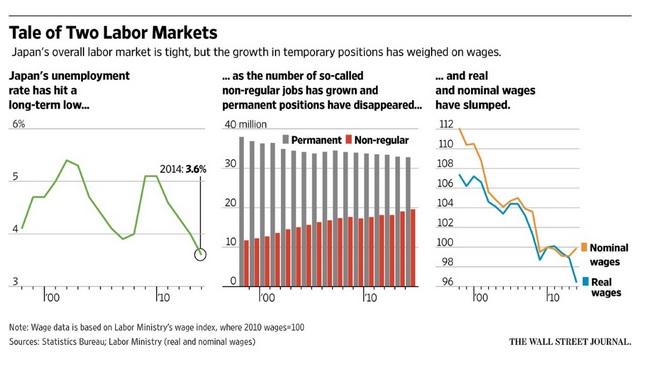
Screenshot via Wall Street Journal
Japanese Prime Minister Shinzo Abe introduced “abenomics” as part of his government’s efforts to spur growth. This consisted of higher prices, making labor rules more flexible and injecting stimulus into the country’s financial system. The result was great…for about two months.
Since the federal government made it easier to allow businesses to give permanent workers the pink slip, companies have slowly replaced them with temp workers. The thought process behind this initiative is to boost hiring. Indeed, it curbed unemployment numbers but it swapped full-time for temp work.
Brazil
There are certain elements of the Brazilian economy that make it costly to conduct any kind of business.
First, the Brazilian economy is fairly unstable. Inflation and currency appreciation has always been the driving force behind Brazil’s value-for-money problem.
In addition, Brazil has very high taxes; 36 percent of gross domestic product. This is much higher than in upper-middle-income countries where the average tax rate is 21 percent.
This combined with very rigid labor laws can make employment costs very high.
According to research by UHY, an international accounting and consultancy network, employment costs in Brazil are 40 times higher than those in Denmark (the country with the lowest employment costs).
Brazilian employers pay approximately $172,667 extra on top of an average gross salary of $300,000. Brazil’s employment costs are high at all salary levels mainly because employers have to bear nearly 50 percent extra costs.
Here is a chart showcasing “payments made by businesses on top of gross salaries by USD and payments as % of gross salary”:
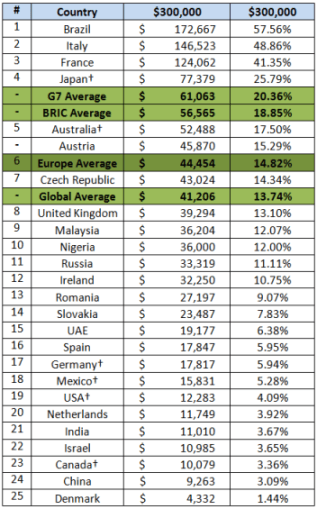
Eric Waidergorn, Director of UHY Moreira and member of UHY in Brazil, says:
“Brazil’s employment costs are exceptionally high, which will hold back new business development and job creation and could encourage informal employment arrangements. While direct personal taxes are low, compared to developed countries and BRICs, high employment costs are a significant hurdle to Brazil’s economic development.”
Employers also face the challenge of finding skilled labor.
Brazil has a poor education system and is considered to be the world’s second-hardest place to find the skills one needs. Labor costs have doubled because of a significant increase in the minimum wage.
Under the Brazilian law, no employee can work more than 44 hours per week. Ideally, this is divided into eight hours Monday to Friday and then four hours on a Saturday. Employees who do not work on a Saturday may exceed eight hours on the weekdays.
Brazilians generally begin work at minimum wage which is R$622 per hour but at this rate, employers can generally get only minimally educated labor. Employees in Brazil accepts company benefits including:
- Cesta básica de alimentos: a box with foods standard to the Brazilian diet such as rice, beans, sugar, coffee, pasta etc. Some employers choose to give money instead of the box. Employees that work with 44h/week are provided with one meal (either the food itself or the price of a regular meal).
- Healthcare: employees are provided healthcare which is usually extended to the employee’s children and spouse.
- Daycare assistance: in many cases, employers pay part of or the complete day-care costs of their employees. They are also known to pay training costs for employees if they require any.
- Life Insurance: although life insurance is an optional benefit, most employees in Brazil provide this to their employees.
- Transportation Costs: Brazilian employers are required by law to provide their employees compensation for transportation to and from work.
- Maternity leave: women are officially allowed to take four months of as maternity leave and still receive a monthly salary. While the government has been advocating increasing this time to six months, companies are not yet obligated to do so. Paternity leave is of five days.
- 13th Salary: the 13th Salary bonus is practiced in several countries including Brazil, Germany and Portugal. For Brazilian employees, the 13th salary is equivalent to one salary that is paid in two portions – one in November and one in December. Every employer is obligated to pay this to their employees.
- Paid vacations: employees can take 30 days off after 12 months of work. Family members working in one company can take vacations together.
- Payroll costs: a primary reason why employees are so costly in Brazil is because of the various charges involved during the hiring process. Employers are charged 68.18 percent of each employee’s payroll every month. This does not include the additional cost of transportation, meals and the other benefits that employers offer to their employees. Altogether, it is safe to estimate that employees generally cost more than the double of their salary.
Overall, it is evident that despite a poorly qualified workforce, lack of skilled labor and low salaries, employment costs in Brazil remain very high because of the inherent charges that are built into the hiring system. The costs end up being so high that employers are unable to take benefit from lower salaries.
A study by the Boston Consulting Group indicates that three quarter of growth in Brazil in the last decades has been from adding more workers, but only a quarter from productivity gains.
David Bailey, CEO 3 Kinds of Ice, explains on Quora how awful, difficult and expensive it is to hire labor in Brazil. Bailey posted a chart to show just how exponential it is to take on permanent employees:
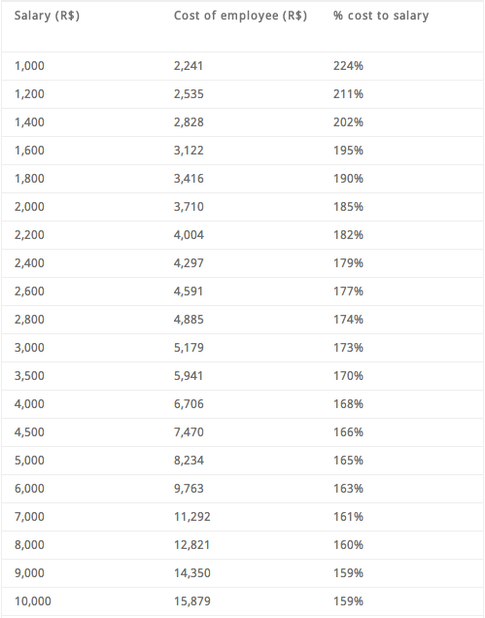
Reasons for the Increase in Temp Workers
Private sector businesses have to deal with an influx of labor costs. From payroll taxes to company benefits, companies usually spend between 15 and 30 percent of gross revenues to payroll percentages, which do vary by industry.
If a company can circumvent these labor costs by bringing temp workers on board then they’ll do it. This pattern has already been established – remember, businesses everywhere have tried to minimize labor costs since the development of the printing press.
In today’s economy, companies have amplified their efforts to increase profits in wake of a alternating marketplace.
Many cite a technological revolution (or automation). Since the public discourse over the $15 minimum wage – Fight for $15 – it seems fast-food companies have revved up their automation process. Just take a look at McDonald’s, Pizza Hut and Chili’s.
Other experts allude to globalization.
In the U.S., critics place the blame on declining employment levels on President Obama’s Affordable Care Act (ACA), otherwise colloquially known as Obamacare. Some purport Obamacare is metastasizing the U.S. into a part-time, temp jobs nation.
Essentially, when labor costs become too costly, companies find ways to adapt and thrive.
Final Thoughts
Although the picture may seem to be the extinction of full-time jobs, it’s not as dire as all that. Let’s face it: there isn’t such a thing as a temp CEO, a temp store manager, a temp software engineer. There will always be a need for permanent positions.
It’s as simple a this: any country or state/province with high payroll and other ancillary job costs will gradually witness a greater number of jobs shift to contractor positions. Brazil, Japan, a large part of Europe and the U.S. are sublime examples of this trend.
No longer is it feasible for public officials and political candidates to just talk about lowering taxes. Instead, if they wish to maintain a blooming workforce, then they will have to espouse how they will diminish the red tape and various mandated labor costs blanketing businesses, large and small alike.

This is a guest post from Andrew Moran, a full-time professional writer, author and journalist who covers the areas of business, economics and personal finance.
Connect on: Amazon | Google+ | Twitter | LinkedIn | YouTube

Rob Rawson is a co-founder of Time Doctor which is software to improve work productivity and help keep track of what your team is working on, even when working remotely.

